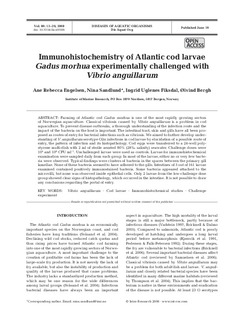| dc.description.abstract | Farming of Atlantic cod Gadus morhua is one of the most rapidly growing sectors
of Norwegian aquaculture. Classical vibriosis caused by Vibrio anguillarum is a problem in cod
aquaculture. To prevent disease outbreaks, a thorough understanding of the infection route and the
impact of the bacteria on the host is important. The intestinal tract, skin and gills have all been proposed
as routes of entry for bacterial infections such as vibriosis. We aimed to further develop understanding
of V. anguillarum serotype O2α infections in cod larvae by elucidation of a possible route of
entry, the pattern of infection and its histopathology. Cod eggs were transferred to a 24-well polystyrene
multi-dish with 2 ml of sterile aerated 80% (28‰ salinity) seawater. Challenge doses were
104 and 106 CFU ml–1. Unchallenged larvae were used as controls. Larvae for immunohistochemical
examination were sampled daily from each group. In most of the larvae, either no or very few bacteria
were observed. Typical findings were clusters of bacteria in the spaces between the primary gill
lamellae. None of these bacteria seemed to have adhered to the gills. Intestines of 3 out of 161 larvae
examined contained positively immunostained bacteria. Some bacteria appeared attached to the
microvilli, but none was observed inside epithelial cells. Only 2 larvae from the low-challenge dose
group showed clear signs of histopathology, which occurred in the intestine. It is not possible to draw
any conclusions regarding the portal of entry. | en |
